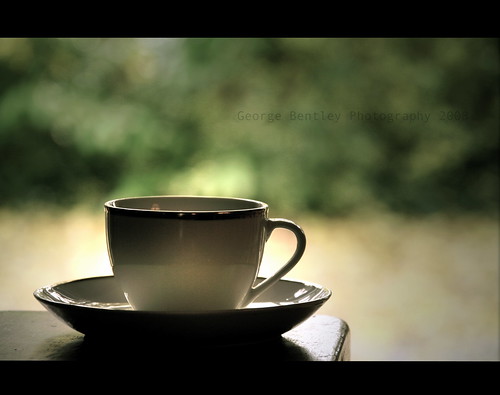Tea and Perfume, Part II: Tea Notes
Black Coffee No Sugar Please Oh And A Little Bit Of Milk, originally uploaded by geeo123.
Unlike the many fragrant plants that are used in perfumery, tea is a subtle note without much diffusiveness. But if you think about it – it makes sense: tea absolute, concrete or extract are made from various kinds of cured tea leaves (Camellia sinensis). And tea leaves have a very subtle fragrance. It is really through the boiling of water that the tea’s complex characteristics of odour, flavour, texture and taste come out. And so it is the perfumer'’s greatest challenge to simulate a tea experience without the essential elements of tea present, and stimulate the wearer’s imagination by fascination with tea.
There are several raw materials that can be used to create the illusion of tea. Some are made of tea itself, some are notes of plants or flowers that are popular in their pairing with tea, and therefore are associated with tea even though they are not necessarily “tea-like”. And there is also a handful of floral absolutes that are reminiscent of tea. Lastly, there are herbs and flowers used to brew tisanes and are popularly described as possessing a tea-like aroma.
Essences from Tea:
Green Tea Absolute
This dark sticky semi-solid mass is not exactly what you’ll think of as impressive tea note. The diffusiveness if very low and even with dilution in alcohol it only opens up very little. It lends an underlining sweet, slightly fruity (apricot) note with a dry woody base. Its very dark in colour and will make the perfume dyed a very dark green.
Green Tea CO2
Of all the tea essences I’ve experienced, green tea CO2 is the most true to nature and accurate. It looks like matcha powder mixed with a little water into a paste and smells pretty close to that to. It is more diffusive, and has a certain herbaceous and nutty element to it, as found in matcha as well. It will dye a perfume only light green but also leaves particles that are non-soluble in alcohol behind.
Black Tea Absolute
More intense than green tea absolute, and a little more mobile (just a little – it still largely resembles dark black molasses). Black Tea absolute has a more diffusive scent but is still quite subtle. I don’t find it as distinctly black as black tea may be. Again, it’s really difficult to have the effect of hot water on the leaf in the absolute form it seems.
Just like the tea, this absolute is bitter, intense, and reminiscent of hay. It lends itself beautifully to Fougere compositions (I’ve used this in Gaucho in a high ratio along with the coumarin from Liatrix, and while there was no oakmoss in there, it still smells very Fougere).
Rooibos Absolute
This absolute from this South African bush is sweet and rich like pipe tobacco. The absolute is very rare to find produced commercially, so it is also possible to make a rooibosn tincture, which has a faint woody slightly sweet aroma but is very subtle.
Connected By Association:
Notes that are often used to scent teas have become so strongly associated with perfume that it’s hard for us to separate them:
Bergamote
The key essence in Earl Gray tea. To many people, the association is so strong that they think of Earl Gray whenever they smell Bergamote.
Jasmine Sambac
The jasmine that is used to perfume jasmine green tea. Jasmine sambac is less animalic and more green and fruity (almost gardenia-like) than the Jasmine grandiflorum variety.
Lavender
Also used in Earl Gray tea as well as brewed as a tisane on its own.
Next: More tea-related notes




2 Comments:
Love reading this! I have made over the month a new perfume with tinctured organic green tea. Thank you for sharing your information!
I've always thought clary sage essential oil had a tea-like aroma.
Post a Comment
<< Home